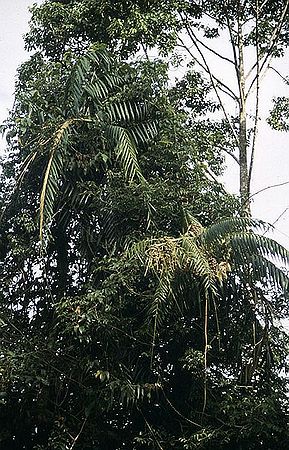Plectocomiopsis geminiflora
| Plectocomiopsis (plehk-toh-KOHM-ee-ohp-siss) geminiflora (Jehm-ihn-ee-FLOHR-ah) | |||||||
|---|---|---|---|---|---|---|---|
 Singapore. | |||||||
| Scientific Classification | |||||||
| |||||||
| Synonyms | |||||||
|
| |||||||
| Native Continent | |||||||
|
| |||||||
| Morphology | |||||||
| |||||||
| Culture | |||||||
|
| |||||||
| Survivability index | |||||||
|
| |||||||
| Common names | |||||||
|
| |||||||
Contents
Habitat and Distribution
Borneo, Cambodia, Laos, Malaya, Myanmar, Sumatera, and Thailand. Local in mixed dipterocarp forest scattered throughout Brunei at altitudes up to 750 m above sea level, but remarkably patchy in distribution. Elsewhere a common rattan throughout Borneo, Sumatra, S Thailand and Peninsular Malaysia.Description
Clustering, moderate to robust rattan with stems to 30 m or more, forming rather dense thickets. Stem without sheaths to 30 mm diam., with sheaths to 60 mm diam., but usually more slender, internodes to 40 cm, shorter in exposed stems. Sheaths generally dull green with persistent grey tomentum and scattered caducous reddish-brown scales, and abundant scattered golden-yellow spines to 8 mm long, the spines sometimes absent on the sheaths subtending the inflorescences; knee absent; ocrea not well developed except on juvenile shoots where irregular, oblique and tattering. Leaf to 3 m including the cirrus to 1 m; petiole present on juvenile stems, absent in adult; leaflets c. 30 on each side of the rachis, regularly arranged, the largest to 40 × 4 cm, bright shining green, concolorous, with short bristles along the margins, the mid nerve on the upper surface with conspicuous golden bristles to 1.5 cm. Inflorescences up to 15 produced simultaneously, the male with more slender branches than the female, to 40 cm, with curving branches to 30 cm bearing clusters of flowers. Ripe fruit oblate, to 2.5 × 3 cm, covered in up to 42 vertical rows of pale greenish to chestnut brown scales. Seed c. 2 × 2 cm; endosperm homogeneous. Seedling leaf bifid. (Fig. 79, Pl. 13B). (J. Dransfield, The Rattans of Brunei Darussalam. 1997)/Palmweb. Editing by edric.
The clustering habit, moderate to robust size, absence of knee and the conspicuous long bristles on the upper surface of the main vein of the leaflets make this a very easily distinguished species. (J. Dransfield, The Rattans of Brunei Darussalam. 1997)
Culture
Cold Hardiness Zone: 10b
Comments and Curiosities
Etymology: Specific epithet from the Latin, Paired flowers.
Uses: The cabbage, although bitter, is highly esteemed, and is sometimes sold in village markets. The cane seems only to be used for coarse basketware and cordage.
- IMAGE GALLERY
External Links
- Glossary of Palm Terms
- MODERN BOTANICAL LATIN
- "Just To Be Clear"
- ! Natural Sciences and Science Education Academic Group, National Institute of Education 1, Nanyang Walk, Nanyang Technological University, Singapore 637616 # Raffles Science Institute, Raffles Institution, One Raffles Institution Lane, Singapore 575954
References
Phonetic spelling of Latin names by edric.
Special thanks to Geoff Stein, (Palmbob) for his hundreds of photos.
Special thanks to Palmweb.org, Dr. John Dransfield, Dr. Bill Baker & team, for their volumes of information and photos.
Glossary of Palm Terms; Based on the glossary in Dransfield, J., N.W. Uhl, C.B. Asmussen-Lange, W.J. Baker, M.M. Harley & C.E. Lewis. 2008. Genera Palmarum - Evolution and Classification of the Palms. Royal Botanic Gardens, Kew. All images copyright of the artists and photographers (see images for credits).
J. Dransfield, The Rattans of Brunei Darussalam. 1997
Many Special Thanks to Ed Vaile for his long hours of tireless editing and numerous contributions.

























